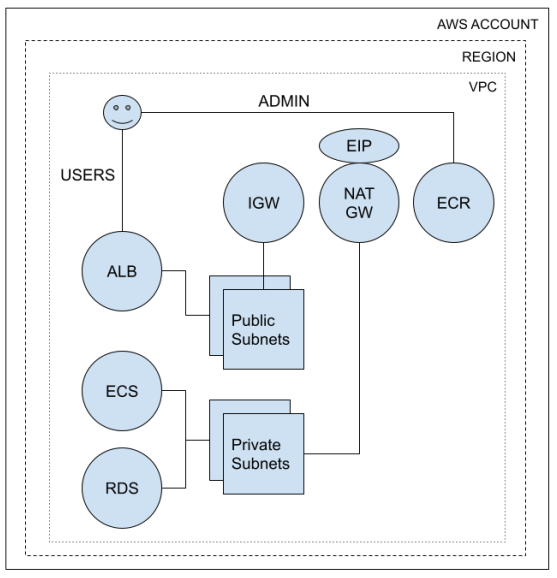NOTE: I spin releases for the latest Keycloak versions avoiding "dot ohs" e.g. 15.1.1+ but not 15.1.0.
Opinionated infrastructure and deployment automation for Keycloak.
- Batteries included (network plumbing + container build/deploy) 🚀
- Tested with latest Terraform 😍
- Prefer fully-managed backing services (Fargate, Aurora, CloudWatch) 🥱
- JDBC clustering and cache replication (improved HA) 🤙
NOTE: The diagram shows the default self-contained publicly-accessible service leveraging the included network module. You can also deploy an internal service (no Internet connectivity) or public service that uses your own network infrastructure. See terraform.tfvars for examples of how to select the right approach for your needs. When deploying to your own network infrastructure, read over the network module to understand how to configure network components.
Psst: Need IaC for your Keycloak clients?
- aws v2 CLI
- aws-vault installed and configured
- Docker (container build/deploy)
- UNIX-like OS (tested on Linux and MacOS)
The basic workflow relies on make to reduce typing toil. If you are just getting started, refer to the bootstrapping guide.
# Create new environment
$ cd environments
$ ./mkenv -e <env_name>
$ cd <env_name>
$ make all
# Update existing environment
$ cd environments/<env_name>
$ vi terraform.tfvars # edit as needed...
$ make update
# Destroy environment
$ cd environments/<env_name>
$ make destroy
# type 'yes' to confirm
# Build Keycloak container and deploy
$ cd build
$ make all ENV=<env_name>Since monitoring approaches vary, I've avoided codifying monitoring-specific opinions to avoid adding cost and complexity. In combination with external synthetics and metrics, you may want to extend this with sidecar containers to provide enhanced monitoring. An example of how to do that with Datadog is included for reference. When adding sidecars, you will need to adjust CPU and memory reservations appropriately. For Datadog, you need to reserve an additional 256 CPU units and 512MB of memory.
Similar to popular frameworks, bootstrap time is reduced by encapsulating technical opinions. This gets functional infrastructure online quickly and consistently. However, you can easily adjust these as needed. This section calls out key design choices.
The Keycloak module itself wraps only a few AWS Terraform primitives, preferring trusted registry modules. Avoiding bespoke solutions where community-tested options exist improves quality and reduces maintenance overhead.
We have contributed to many of these modules ourselves, and leverage them for production infrastructure. We've taken the time to read the module source, understand how they work, and reason about the choices they've made. You should do the same. Dependencies are conveniently linked in References.
While there are a number of modules to create AWS network resources, networking is an exception to the re-use rule above. The provided network module is simplistic, but adequate and easy to adjust based on your requirements.
It is meant to serve two purposes: a starting point to get new environments online quickly, and interface documentation. Taking it's outputs as an example, you can easily provide similar inputs via configuration from existing infrastructure or a module of your choice.
Whether ALB listeners, ECR, RDS, or remote state... anything that can have encryption enabled does by default. Aside from belief in the cypherpunk motto, this is due to the fact Keycloak is a security service.
The one exception today is intra-VPC traffic between the ALB and ECS containers. Fixing this so service traffic is FULLY encrypted is on the TODO list (PRs welcome).
Aside from just "turning it on", thought is being given to cert management, workflow, etc. For example, a sidecar proxy integrated with Let's Encrypt would be more up-front complexity but not require updating container trust stores, worrying about renewals, etc.
Upstream defaults are used when sensible. Settings unlikely to change in the typical case have local defaults or are hard-coded (e.g. DB port number). The goal is to reduce cognitive load, but these are only opinions that you can override.
The included standalone-ha.xml and docker-entrypoint.sh have been adjusted to work with ECS out of the box. These should generally suffice, but may need adjusted based on your requirements. You might also want to toggle different feature flags, which are controlled in profile.properties.
- Terratests
- ALB -> ECS TLS
- Performance test automation + baseline
- Multi-region support
- MySQL support
- https://github.com/cloudposse/terraform-aws-tfstate-backend
- https://github.com/cloudposse/terraform-null-label
- https://github.com/cloudposse/terraform-aws-alb
- https://github.com/cloudposse/terraform-aws-ecs-alb-service-task
- https://github.com/cloudposse/terraform-aws-ecr
- https://github.com/cloudposse/terraform-aws-rds-cluster
- https://hub.docker.com/r/jboss/keycloak
- https://www.keycloak.org/docs/latest/server_installation/index.html
- https://www.keycloak.org/docs/latest/upgrading/index.html
- https://docs.datadoghq.com/integrations/ecs_fargate
- https://docs.datadoghq.com/integrations/faq/integration-setup-ecs-fargate
- https://docs.datadoghq.com/agent/guide/autodiscovery-with-jmx
Abandon hope all ye who enter here... :-)
- https://www.keycloak.org/docs/latest/server_installation/index.html#_clustering
- https://infinispan.org/docs/stable/index.html
- https://www.keycloak.org/2019/05/keycloak-cluster-setup.html
- https://www.keycloak.org/2019/08/keycloak-jdbc-ping
- http://jgroups.org/manual/#JDBC_PING
- https://octopus.com/blog/wildfly-jdbc-ping
Q: The target group with targetGroupArn <arn> does not have an associated load balancer.
A: This is rare, but if it happens to you just re-run make all (double apply), perhaps waiting a few minutes in between.
Q: How do I get support?
A: Open GitHub issues. If there's a bug you know how to fix, also open a PR and link it in your issue.
